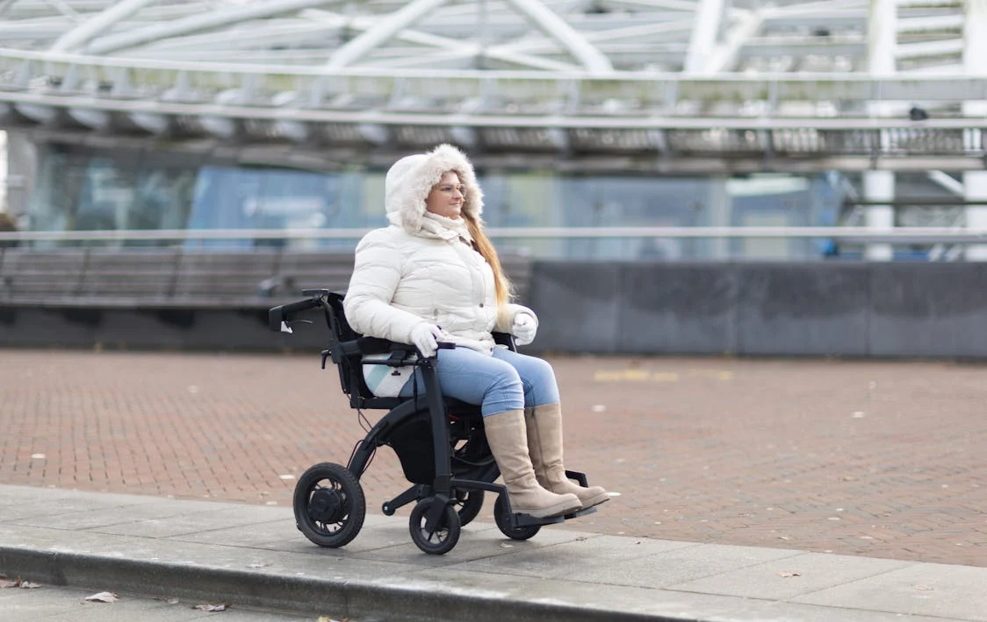
@ShahidNShah


Mobility is synonymous to freedom, independence, and quality of life. For individuals who rely on electric wheelchairs, recent technological advancements are making that mobility even more accessible.
The latest innovations are redefining what’s possible, from AI-powered navigation and voice-controlled features to lightweight, foldable designs.
Modern electric wheelchairs offer longer battery life, adaptive seating, and even all-terrain capabilities, ensuring users can move easily and confidently. As technology continues to evolve, these breakthroughs are enhancing mobility and transforming lives.
For years, electric wheelchairs have provided essential mobility support, but recent advancements in smart navigation and AI integration are taking independence to the next level. These cutting-edge innovations make movement easier, safer, and more intuitive for users.
Some electric wheelchairs now feature smart navigation systems that help users avoid obstacles, adapt to different environments, and even learn their daily routes. Using advanced sensors and machine learning, these wheelchairs can analyse surroundings in real time, preventing collisions and enhancing safety.
Some models also offer autonomous driving features, allowing users to navigate hands-free through voice commands or smartphone apps.
Another breakthrough is AI-assisted predictive movement. A wheelchair that adapts to a user’s driving patterns can anticipate turns, speed adjustments, and stopping points, creating a more fluid and natural movement experience.
Additionally, GPS-enabled technology allows for seamless outdoor travel, ensuring users can confidently navigate busy streets and unfamiliar locations.
These advancements are not just about convenience; they are transforming lives. With AI-driven features, electric wheelchairs are becoming more than just mobility devices—they are smart companions that promote independence and confidence. As technology continues to evolve, the future of mobility looks more promising than ever.
Advancements in electric wheelchair technology have significantly enhanced mobility and independence for individuals with physical impairments. A notable development is the emergence of lightweight and foldable electric wheelchairs designed for easy transport and storage.
Traditionally, electric wheelchairs were heavy, limiting users’ ability to travel freely. Modern designs utilise materials like carbon fibre and aerospace-grade aluminium, resulting in models weighing as little as 28 pounds without the battery.
For instance, the X-lite Ultra Lightweight Foldable Electric Wheelchair exemplifies this innovation, offering users a highly portable mobility solution.
The global market for lightweight electric folding wheelchairs reflects this trend, with projections indicating growth from $5.17 billion in 2024 to $5.76 billion in 2025, at a compound annual growth rate of 11.5%. This surge underscores the increasing demand for portable mobility solutions that do not compromise performance or comfort.
These advancements empower users to maintain active lifestyles, offering greater freedom and flexibility. As technology continues to evolve, we can anticipate further enhancements in the design and functionality of electric wheelchairs, contributing to improved quality of life for many individuals.
Advancements in battery technology have significantly enhanced the performance and reliability of electric wheelchairs, offering users greater mobility and independence. The transition from traditional lead-acid batteries to lithium-ion (Li-ion) batteries has been pivotal in this evolution. Li-ion batteries are renowned for their higher energy density, reduced weight, and extended lifespan, which directly translate to longer travel ranges and improved user experience.
Furthermore, integrating regenerative braking systems has contributed to energy efficiency in electric wheelchairs. These systems capture and store energy during deceleration or downhill movement, subsequently utilising this reclaimed energy to power the wheelchair, extending battery life and reducing the frequency of charging cycles.
These advancements in battery technology have revolutionised electric wheelchairs, providing users with enhanced range, reliability, and overall satisfaction.
Advancements in electric wheelchair technology have significantly enhanced user autonomy and convenience, notably by integrating voice and app-controlled features. These innovations empower individuals with mobility challenges to navigate their environments more independently and interact seamlessly with modern smart devices.
Voice-controlled wheelchairs enable users to operate their mobility devices using simple verbal commands, eliminating the need for manual controls.
This technology particularly benefits individuals with limited hand or arm mobility, allowing them to direct their wheelchairs efficiently and safely. For instance, early developments in this field demonstrated wheelchairs responding to specific voice instructions, enhancing user autonomy.
In addition to voice controls, modern electric wheelchairs are increasingly equipped with Bluetooth capabilities, facilitating integration with smartphones and tablets. This connectivity allows users to control various functions of their wheelchairs through dedicated mobile applications, such as adjusting seating positions or monitoring battery status.
Moreover, these Bluetooth-enabled systems can interface with smart home devices, enabling users to manage household appliances directly from their wheelchair controls, enhancing their overall quality of life.
The convergence of voice recognition and mobile app integration in electric wheelchairs represents a significant stride towards personalised mobility solutions, offering users greater independence and seamless interaction with their surroundings.
Advancements in electric wheelchair design have significantly improved user comfort and posture through adaptive seating and ergonomic features. Modern wheelchairs offer highly adjustable seating systems tailored to individual needs, enhancing support and mobility.
Adaptive seating systems allow for precise adjustments in seat depth, width, backrest angle, and leg rest positioning, accommodating various body types and medical requirements. For instance, the SEDEO PRO seating system provides a customizable frame with multiple support options, enabling users to achieve optimal seating posture.
Ergonomic enhancements, such as specialized seat cushions and adjustable footrests, are crucial in promoting proper posture and reducing the risk of pressure ulcers. These features distribute body weight evenly and support natural alignment, contributing to overall well-being.
The concept of active sitting, which encourages movement while seated, has also been integrated into wheelchair design. Dynamic seating systems accommodate involuntary movements and muscle tone variations, providing stability and comfort for users with conditions like cerebral palsy.
These advancements in adaptive seating and ergonomics have transformed electric wheelchairs into personalised mobility solutions, enhancing user independence and quality of life.
Electric wheelchair technology is advancing incredibly, bringing users greater freedom, comfort, and independence. These innovations, from AI-driven navigation to lightweight designs and voice controls, are redefining mobility. As research continues, we can expect even smarter, more adaptable solutions that enhance users’ quality of life.
The future of mobility isn’t just about movement—it’s about empowerment, accessibility, and limitless possibilities. These advancements are transforming lives by enhancing navigation through busy streets, optimizing seating for comfort, and making travel more effortless. The road ahead is bright, and electric wheelchairs pave the way for a more inclusive world.

While the integration of digital health technologies and artificial intelligence (AI) in cardiovascular and emergency medicine have the ability to transform patient care, these tools can face social …
Posted Mar 14, 2025 Digital Health Innovation
Connecting innovation decision makers to authoritative information, institutions, people and insights.
Medigy accurately delivers healthcare and technology information, news and insight from around the world.
Medigy surfaces the world's best crowdsourced health tech offerings with social interactions and peer reviews.
© 2025 Netspective Foundation, Inc. All Rights Reserved.
Built on Apr 17, 2025 at 6:07am